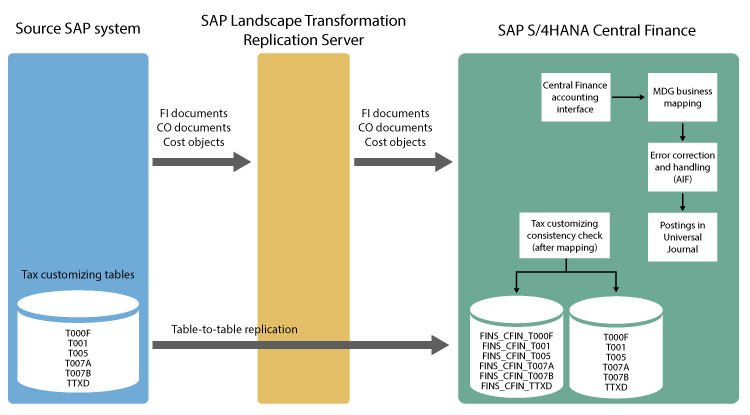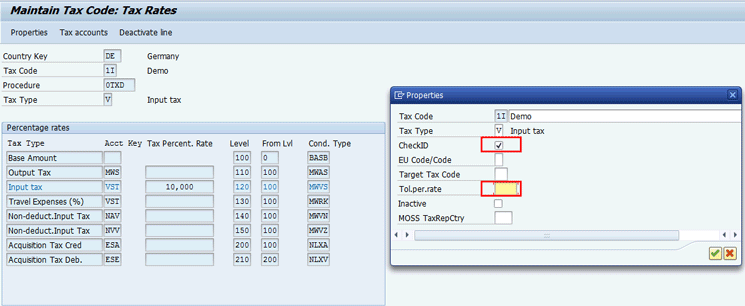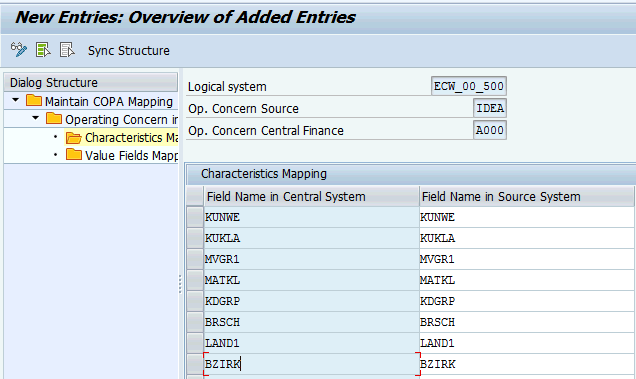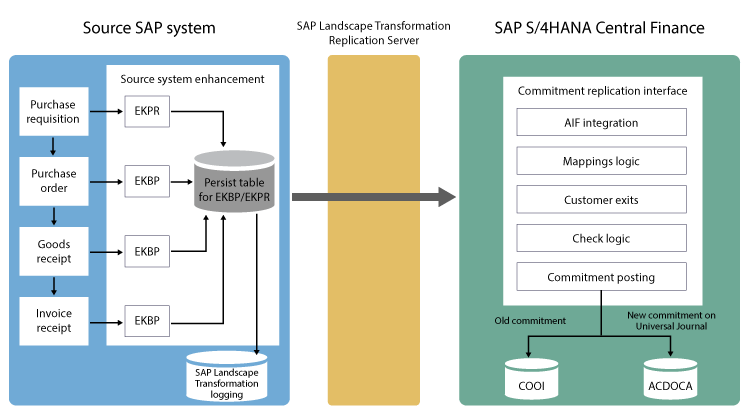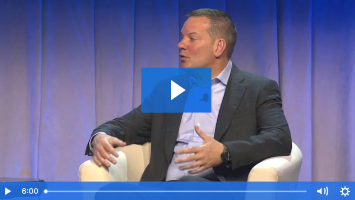Accelerate Your Finance Shared Services Transformation and Centralized Reporting
SAP S/4HANA 1709 Offers New Features for SAP S/4HANA for Central Finance Foundation
New features have been introduced in SAP S/4HANA 1709 that enable enterprises to leverage the benefits of shared services for certain financial processes along with added reporting flexibilities. In this blog, I provide a quick overview of the innovations in SAP S/4HANA 1709 along with some key considerations and limitations while implementing them. I focus on three features:
- Central payments
- Central tax check and reporting
- The Profitability Analysis (CO-PA) replication tool for central profitability reporting
New features have been introduced in SAP S/4HANA 1709 that enable enterprises to leverage the benefits of shared services for certain financial processes along with added reporting flexibilities. In this blog, I provide a quick overview of the innovations in SAP S/4HANA 1709 along with some key considerations and limitations while implementing them. I focus on three features:
- Central payments
- Central tax check and reporting
- The Profitability Analysis (CO-PA) replication tool for central profitability reporting
Explore related questions
Central Payments
With this feature the vendor and customer open items and invoices replicated from source systems can be paid or cleared centrally in SAP S/4HANA for central finance foundation (Central Finance). The open items are technically cleared in the source system immediately once they are replicated to Central Finance, to avoid duplicate payments in the source and Central Finance systems.
The activation of the Central Payments functionality is done for each source system company code. Figure 1 shows a vendor invoice posted in a source system for a company code for which the Central Payments feature is activated in Central Finance. To post this vendor invoice, execute transaction code FB60 or follow menu path Accounting > Financial Accounting > Accounts Payable > Document entry > Invoice. Note that the Clrng doc. (clearing document number) field (BSEG-AUGBL) is filled with the value ALE-extern in the source system automatically during replication of this document to Central Finance, representing technical clearing. The open item can then be paid or cleared only in the Central Finance system.
With Central Payments functionality, enterprises with a distributed landscape can centralize the payment, receivables, and payables monitoring processes to leverage the benefits of shared services. Additionally, if SAP Bank Communication Management and SAP In-House Cash functionalities are implemented in the Central Finance system, Central Payments can integrate with these functions for improved working capital management.
To activate the central payment functionality, you need to maintain a customizing table in IMG menu path Financial Accounting > Central Finance > Central Payment > Activate Central Payment for company code. As shown in Figure 2 you need to populate the fields under the Logical sys… (logical system) and Source Co… (source company code) columns. In the Scope column, you select Central Payment with VAT Configuration Check Active. However, it is important to note that before maintaining this customizing, the steps for activation of Central Payments functionality as listed in SAP Note 2346233 need to be followed in sequence.
Here are some of the key points for you to consider before deciding on activation of Central Payments functionality in a Central Finance system company code:
- Certain period-end closing transactions (e.g., foreign currency valuation) for a Central-Payments-activated company code need to be done in both the source system and the Central Finance system.
- Full balance sheet and profit and loss (P&L) for reporting are only available from the Central Finance system.
- All value-added tax (VAT) and withholding tax reporting, including deferred tax reporting, can only be done from the Central Finance system. However, there are limitations to the reports that are available from Central Finance that need to be considered. SAP Note 2509047 provides details on these limitations.
- Since the central payment documents are not replicated back to the source system, the actual clearing status of open items is not available in the source for any customer and vendor reports.
- Since there is no sales and purchase order information passed to the Central Finance system, down payment requests with references to sales or purchase orders cannot be posted in the Central Finance system. Also refer to SAP Note 2346233 for a detailed list of restrictions with central payment functionality and steps to activate this functionality.
Central Tax Check and Reporting
With SAP S/4HANA 1709, two new tax checks are available to facilitate centralized tax reporting from the Central Finance system:
- Tax customizing consistency check
- Tax Recalculation Check
With activation of Central Payments functionality, it is also mandatory to activate these checks for the relevant company codes since tax reporting is done from the Central Finance system.
The Tax Customizing Consistency Check
The tax customizing consistency check ensures that tax-related customizing in the source and Central Finance systems is consistent by replication of key tax-related customizing tables from the source to Central Finance system through the SAP Landscape Transformation Replication Server, as shown in Figure 3.
The tax customizing tables shown in Figure 3 are replicated through the SAP Landscape Transformation Replication Server from the source system to the Central Finance system. The replicated tables in the Central Finance system can be seen prefixed with FINS_CFIN. During replication of any financial postings from the source system to the Central Finance system, the entries in these replicated tables (FINS_CFIN..) in Central Finance are compared with corresponding tax customizing table entries in Central Finance, after considering the mapping maintained in Central Finance. If any tables entries are missing then an error message is displayed and the posting is blocked in the SAP Application Interface Framework (AIF). Here are some examples of these types of errors:
- The Not deductible indicator does not match in the source and target systems.
- The activation status of plants abroad does not match in the source and target systems.
- The EU country indicator does not match in the source and target systems.
Refer to SAP Note 2494127 for detailed descriptions of the tax customizing tables involved and steps to set up the SAP Landscape Transformation Replication Server for replication of these tables.
The Tax Recalculation Check
The Tax recalculation check compares the tax posting values replicated with the financial postings from the source system with the calculated tax values based on the configuration in the Central Finance system. If there are any differences exceeding the threshold defined, then an error message is displayed, and the posting is blocked in AIF in Central Finance. To set up two key prerequisites for this check, execute transaction code FTXP or follow IMG menu path Financial Accounting (New) > Financial Accounting Global Settings > Tax on Sales/Purchases >Calculation > Define Tax Codes for Sales and Purchases. This path displays the screen shown in Figure 4. The two prerequisites are:
- The CheckID indicator should be active in relevant tax codes in transaction FTXP (field T007A-PRUEF=X)
- The Tol.per.rate (tolerance percentage rate) field should be zero (T007A-TOLERANCE) wherever possible. Check SAP Notes 943614 and 956637.
To activate both of these tax checks for centralized tax reporting in the Central Finance system, the activation for the relevant source system and company code needs to be done in the Central Finance system. To complete this step follow IMG menu path Financial Accounting > Central Finance > General Settings > Activate VAT Configuration check for company codes. This menu takes you to the screen shown in Figure 5. Enter the name of the source system in the Logical sys…(Logical system) field and the source system’s company code in the Src CoCode (Source company code) field. Select the VAT Configuration Check Active option in the Scope column as shown in Figure 5. For the company codes for which Central Payment functionality is also activated as explained in the “Central Payments” section, an entry is automatically seen in this configuration node with the value Central Payment with VAT Configuration Check Active in the Scope column. This is because activation of VAT configuration check is mandatory for the company codes for which the Central Payments feature is activated.
Here are some key points to consider before deciding on activation of central tax checks and reporting in Central Finance:
- It is mandatory to activate this check for the relevant source system company code for which central payment functionality is activated in the Central Finance system. For others it is optional.
- The Advanced Compliance Reporting solution in SAP S/4HANA can be leveraged in Central Finance for country-specific tax reporting. However, not all VAT reports and countries are supported for centralized tax reporting in Central Finance. Refer to SAP Note 2509047 for the restrictions on centralized tax reporting from Central Finance for each of the core tax reports.
- Tax reporting, including that for deferred tax for the period of the initial load in the Central Finance system during which only balances and open items are loaded, cannot be done in the Central Finance system. This is because the line-item details are not available in Central Finance for this period, and therefore, relevant information for tax reporting is also missing in the Central Finance system.
- If an external tax calculation system is used for tax calculation in the source system, then the same external tax calculation system should be used in the Central Finance system.
The CO-PA Replication Tool for Central Profitability Reporting
A replication of costing-based CO-PA in the source system to account-based CO-PA in the Universal Journal in the Central Finance system is not supported out of the box in SAP S/4HANA. Since most enterprises have been using costing-based CO-PA for many years in their source systems, it is a challenge for them in Central Finance to achieve central profitability reporting. However, in S/4HANA 1709 a custom replication tool set has been provided to enable this replication from costing-based CO-PA to account-based CO-PA in the Universal Journal.
Costing-based CO-PA is a form of profitability analysis in which costs and revenues are grouped based on value fields and costing-based valuation approaches in separate persistence tables (CE1XXXX). Account-based CO-PA is a form of profitability analysis in which costs and revenues are stored in general ledger (G/L) accounts. CO-PA in the Universal Journal refers to a new form of CO-PA that is available with SAP S/4HANA and is technically based on account-based CO-PA. Profitability characteristics and the G/L accounts are stored directly in the line item in the Universal Journal in this solution. Both costing-based CO-PA and CO-PA in the Universal Journal are supported in SAP S/4HANA; however, no further developments are planned by SAP on costing- based CO-PA in the future.
With this functionality characteristics and value fields in the source system can be mapped to characteristics and value fields in the Central Finance system. During the replication of CO-PA documents from the source system, the Central Finance system determines the value of each characteristic or value field of a document based on the corresponding field in the source document and the mapping configured.
To maintain the mapping follow IMG menu path Financial Accounting > Central Finance > Mapping > COPA Mapping > Define COPA mapping. This path takes you to the screen in Figure 6. The mapping can be maintained for each combination of source operating concern and Central Finance operating concern. Also, many operating concerns in the source system can also be mapped to a single operating concern in Central Finance. If changes have been made in any of the characteristics or value fields in the source system or the Central Finance system, then click the Sync Structure button to update the mappings to reflect these changes.
Here are some key points to consider:
- Replication from costing-based CO-PA in the source system to costing-based CO-PA in Central Finance is not supported. Replication from account-based CO-PA in the source system to costing-based CO-PA in Central Finance is also not supported.
- Note that the mapping only determines the corresponding characteristics to be fed in the Universal Journal in the Central Finance system when Financial Accounting (FI) or Controlling (CO) posting are replicated, from costing-based CO-PA in the source system. The values for characteristics itself are derived from the CO-PA derivation rules maintained after executing transaction code KEDR in the Central Finance system as part of standard CO-PA derivation rules.
- Costing-based CO-PA postings from settlement to CO-PA (transaction code KOAO), assessment to CO-PA (transaction code KSPA), and Actual Inverse Activity allocation (transaction code RKIL) can be converted to CO-PA in the Universal Journal in the Central Finance.
- Postings made only in costing-based CO-PA and not in FI or CO in the source system such as top-down distribution in CO-PA are not supported for replication to the Central Finance system.
Besides the three key innovations above, here is a quick overview of other innovations introduced with SAP S/4HANA 1709 for the Central Finance solution. For more details with a step-by-step process for setup of these functionalities, refer to the Central Finance configuration guide.
(EC-PCA) Replication: In many of the source systems classic profit center accounting (EC-PCA) is active. Postings that happen in FI or CO in the source systems if they carry a profit center in line items are replicated in Central Finance and updated with profit center details in the Universal Journal. However, postings that happen only in EC-PCA in source systems — for example, manual postings (transaction codes 9KE0 and 1KEL) and allocations (transaction codes 4KE5 and 3KE5) — were not replicated in the Central Finance system. With SAP S/4HANA 1709, even these postings can be replicated in Central Finance through SAP Landscape Transformation. Similar to FI and CO documents replication, AIF is used for error handling and correction while the business mapping functionality is used with Master Data Governance (MDG) for replication of these EC-PCA documents. In the Central Finance system these EC-PCA-only postings from source systems are replicated as FI documents in the Universal Journal, with the details of original EC-PCA documents from the source system in reference field (BKPF-AWTYP, AWSYS) of the Central Finance document. Additionally, a dedicated ledger group and document type can be defined in Central Finance for these postings. For one-sided EC-PCA documents a G/L account for offsetting lines needed to balance the document to zero can be defined.
Central Commitment reporting: With this functionality commitments and updates are replicated to the Central Finance for these scenarios:
- Replication of commitment and updates from purchase requisitions or purchase orders in source systems
- Replication of a commitment update from goods receipt and invoice receipts in source systems
This functionality can facilitate centralized commitment reporting from the Central Finance system only for the above scenarios. The initial load of commitments is also supported, and an initial load preparation report is provided to simulate commitment posting for an existing purchase requisition (PR) or PO. The architecture for the commitment replication is shown in Figure 7. In the source system the commitments are updated in a persistence table based on PO and PR tables EKPR and EKBP. From the persistence tables the commitments are replicated through SAP Landscape Transformation Replication server to Central Finance. The error handling is handled in AIF and the business mappings in MDG in Central Finance. Finally the commitment posting is done in Central Finance, which updates the old commitment line items table COOI as well as the Universal Journal in table ACDOCA.
Since this functionality is only available from SAP S/4HANA 1709 FPS01, a downport is available with SAP Note 2554827for enterprises on SAP S/4HANA 1709 FPS00.
Central Projects and work breakdown structure (WBS) reporting: With this functionality in SAP S/4HANA 1709 project definitions and WBS elements (transaction codes CJ01 and CJ11) can be replicated from source systems to Central Finance. The FI and CO postings that are replicated from source systems to Central Finance can carry this information that can enable centralized projects reporting from Central Finance. Also, any changes made to project definitions and WBS elements can be replicated. Application Link Enabling (ALE) is used for replication through Intermediate Documents (IDocs) for initial load as well as subsequent replications for project definitions and WBS elements. Error handling is done through AIF, while business mapping is done through MDG in Central Finance.
Report FINS_Central Finance_PS_CHECK can be used for checking the configuration between source systems and Central Finance systems before starting replication
Enterprises that want to implement this functionality in Central Finance should note that it supports only project costs and revenue reporting in Central Finance for postings originating from source systems.
However, other project-based functionalities such as planning, budgeting, settlement, and results analysis can take place only in source systems because all the related logistics data for these processes is in source systems and not replicated to Central Finance.
SAP S/4HANA public cloud integration: If the source system is on an SAP S/4HANA public cloud, it can connect to SAP S/4HANA Central Finance On-premise through SAP Landscape Transformation for replication of FI documents along with AIF and business mapping functionality. However, key restrictions to be considered by enterprises are that there are no initial load functionalities and replication of CO postings and replication of cost objects from the source SAP S/4HANA public cloud system is not supported.
Configuration Consistency Check: A new report for checking the consistency of configuration between source systems and Central Finance systems is available through transaction code FINS_Central Finance_CC. This report enables you to check the customizing parameters between the source system and the Central Finance system along with master data settings before initial load and real-time replication. Some of the key checks between the source and Central Finance systems in the report include:
- Currency checks: Local currency of company code and accounts currency of G/L accounts
- Document splitting Active/inactive check
- G/L Account: Account type (Balance Sheet, P&L, Primary element), Account currency, and Open item management indicator
- Various Value Added tax checks for fields in various customizing tables related to company code and tax code (e.g., country, country exchange rate type, plants abroad, tax jurisdiction code, VAT registration number, and tax category tax type)
The report does not cover a consistency check for all the configurations between the source system and the Central Finance system, but is limited to only a few. Manual analysis would still need to be performed for those checks that are not covered in this report.



